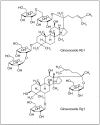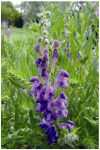Neuroprotective herbs and foods from different traditional medicines and diets
- PMID: 20657497
- PMCID: PMC6263339
- DOI: 10.3390/molecules15053517
Neuroprotective herbs and foods from different traditional medicines and diets
Abstract
Plant secondary metabolites include an array of bioactive constituents form both medicinal and food plants able to improve human health. The exposure to these phytochemicals, including phenylpropanoids, isoprenoids and alkaloids, through correct dietary habits, may promote health benefits, protecting against the chronic degenerative disorders mainly seen in Western industrialized countries, such as cancer, cardiovascular and neurodegenerative diseases. In this review, we briefly deal with some plant foods and herbs of traditional medicines and diets, focusing on their neuroprotective active components. Because oxidative stress and neuroinflammation resulting from neuroglial activation, at the level of neurons, microglial cells and astrocytes, are key factors in the etiopathogenesis of both neurodegenerative and neurological diseases, emphasis will be placed on the antioxidant and anti-inflammatory activity exerted by specific molecules present in food plants or in remedies prescribed by herbal medicines.
Figures
















Similar articles
-
Bioactive compounds and health benefits of edible Rumex species-A review.Cell Mol Biol (Noisy-le-grand). 2018 Jun 25;64(8):27-34. Cell Mol Biol (Noisy-le-grand). 2018. PMID: 29981688 Review.
-
Health benefits of herbs and spices: the past, the present, the future.Med J Aust. 2006 Aug 21;185(S4):S1-S24. doi: 10.5694/j.1326-5377.2006.tb00548.x. Med J Aust. 2006. PMID: 17022438 Review.
-
Neuroprotective Potential of Secondary Metabolites from Melicope lunu-ankenda (Rutaceae).Molecules. 2019 Aug 27;24(17):3109. doi: 10.3390/molecules24173109. Molecules. 2019. PMID: 31461914 Free PMC article. Review.
-
Anti-Inflammatory Drugs and Herbs with Special Emphasis on Herbal Medicines for Countering Inflammatory Diseases and Disorders - A Review.Recent Pat Inflamm Allergy Drug Discov. 2018;12(1):39-58. doi: 10.2174/1872213X12666180115153635. Recent Pat Inflamm Allergy Drug Discov. 2018. PMID: 29336271 Review.
-
Neuroprotective potential of phytochemicals.Pharmacogn Rev. 2012 Jul;6(12):81-90. doi: 10.4103/0973-7847.99898. Pharmacogn Rev. 2012. PMID: 23055633 Free PMC article.
Cited by
-
Much More than Nutrients: The Protective Effects of Nutraceuticals on the Blood-Brain Barrier in Diseases.Nutrients. 2025 Feb 21;17(5):766. doi: 10.3390/nu17050766. Nutrients. 2025. PMID: 40077636 Free PMC article. Review.
-
Mechanosensory Neuron Aging: Differential Trajectories with Lifespan-Extending Alaskan Berry and Fungal Treatments in Caenorhabditis elegans.Front Aging Neurosci. 2016 Jul 18;8:173. doi: 10.3389/fnagi.2016.00173. eCollection 2016. Front Aging Neurosci. 2016. PMID: 27486399 Free PMC article.
-
Neurotrophic natural products: chemistry and biology.Angew Chem Int Ed Engl. 2014 Jan 20;53(4):956-87. doi: 10.1002/anie.201302268. Epub 2013 Dec 18. Angew Chem Int Ed Engl. 2014. PMID: 24353244 Free PMC article. Review.
-
Ethnomedicinal uses of plants for the treatment of nervous disorders at the herbal markets of Bojnord, North Khorasan Province, Iran.Avicenna J Phytomed. 2019 Mar-Apr;9(2):153-163. Avicenna J Phytomed. 2019. PMID: 30984580 Free PMC article.
-
Glutathione and Related Molecules in Parkinsonism.Int J Mol Sci. 2021 Aug 13;22(16):8689. doi: 10.3390/ijms22168689. Int J Mol Sci. 2021. PMID: 34445395 Free PMC article. Review.
References
Publication types
MeSH terms
Substances
LinkOut - more resources
Full Text Sources

